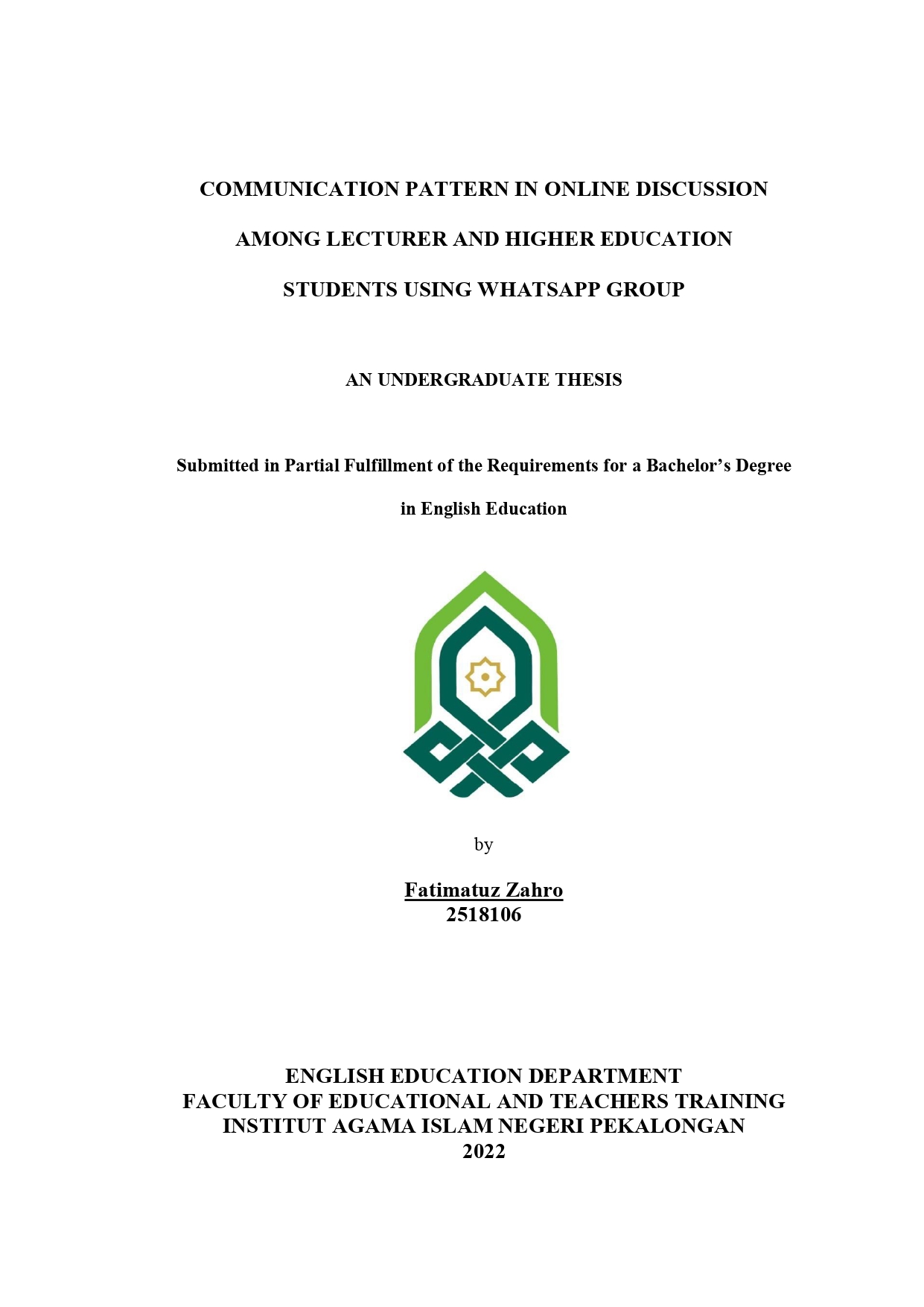
SKRIPSI TADRIS BAHASA INGGRIS
Communication Pattern in Online Discussion Among Lecturer And Higher Education Students Using Whatsapp Group
In an online discussion, WhatsApp Group is used as a learning tool. This study aims to explore how the communication patterns between the lecturer and students in online discussion using WhatsApp Group, and also to find obstacles faced by lecturer and higher education students during online discussion and also strategies to overcome them. This research approach used qualitative research. Data were obtained through observation, semi-structured interviews, and documentation, and were analyzed with the theory of Tubbs (2012). The partisipants of this research are 1 lecturer and 5 students who took the Academic Reading and Writing Course at one of the universities in Pekalongan. The findings showed that every student and the lecturer can communicate freely and openly, the communication pattern used is All-Channel Communication Pattern. Besides that, the lecturer and students have obstacles during the discussion. Most of the students had a bad connection; many incoming messages; students can not manage their time; and students could have seen the answers of their friends; and then the lecturer also felt that he must be able to think creatively to encourage students to participate in online learning. Therefore, the lecturer provide strategies to improve communication in online learning, for example, the lecturer must provide feedback to all students; the lecturer also must be able to control students to be involved in the class; and also be able to create a fun class so that students are not bored in the online class.
Keyword: Communication Pattern, Online Discussion, WhatsApp Group
REFERENCE
Ali, M. S. S., & Kootbodien, A. (2017). The Effectiveness of WhatsApp as an Interpersonal Communication Medium among Abu Dhabi University Students. International Journal of Media, Journalism and Mass Communications (IJMJMC). 3(1), 11-19.
DOI: http://dx.doi.org/10.20431/2454-9479.0301002
Azeharie, S., & Khotimah, N. (2015). The Patterns of Interpersonal Communication between Teachers and Students in Children Daycare "Melati" in Bengkulu, Jurnal Pekommas, 18(3), 213 – 224.
Aziz, F., & Kazi, A. S. (2019). Role of Teachers in Students’ Classroom Participation in Universities. International Journal of Education Enquiry and Reflection, 4(1), 46-57.
Chan, T. J., Yong, W. K., & Harmizi, A. (2020). Usage of WhatsApp and Interpersonal Communication Skills among Private University Students. Journal of Arts & Social Sciences, 3(2), 15-25.
Ermi, N. (2015). Penggunaan Metode Diskusi untuk Meningkatkan Hasil Belajar Materi Perubahan Sosial pada Siswa Kelas XII SMA Negeri 4 Pekanbaru. Jurnal SOROT, 10(2), 155-168.
Hanafi, & Nuraini, K. (2019). Teacher Communication Pattern in English Learning Process as Foreign Language in Senior High School.
Proceeding of the 6th International Conference on Community Development (ICCD 2019). Atlantis Press. Hal. 205-208.
DOI: https://doi.org/10.2991/iccd-19.2019.55
Harmer, J. (1990). The Practice of English Language Teaching. Twelfth Impression. New York: Longman Inc.
Herwiana, S. & Laili, E. N. (2022). Exploring Benefits and Obstacles of Online Learning During the COVID-19 Pandemic in EFL Students’ Experiences. Qalamuna: Jurnal Pendidikan, Sosial, dan Agama. 14.(1). 61-72
Kale, U., Brush T., Bryant, A., & Saye, J. (2011). Online Communication Patterns of Teachers. Journal of Interactive Learning Research. 22(4), 489-520.
Mckimm, J. (2009). Giving Effective Feedback. British Journal of Hospital Medicine. 70(3). 158-161. DOI:10.1177/108482239801000215
Miles, M. B., Huberman, A. M., & Saldana, J. (2014). Qualitative Data Analysis: A Methods Sourcebook (3rd ed). Thousand Oaks, CA: Sage Publications.
Mistar, I. binti & Embi. M. A. (2016). Students’ Perception on the Use of WhatsApp as a Learning Tool in ESL Classroom. Journal of Education and Social Sciences. (4). 96-104.
Ketersediaan
| 23SK2325013.00 | SK TI 23.013 FAT c | My Library (Lantai 3. Local Content) | Tersedia |
Informasi Detail
- Judul Seri
-
-
- No. Panggil
-
SK TI 23.013 FAT c
- Penerbit
- Pekalongan : Jurusan S-1 Tadris Bahasa Inggris FTIK UIN K.H. Abdurrahman Wahid Pekalongan., 2022
- Deskripsi Fisik
-
xvii, 39 hlm., 30 cm; Bibliografi: 40-43
- Bahasa
-
Inggris
- ISBN/ISSN
-
-
- Klasifikasi
-
302. 22
- Tipe Isi
-
-
- Tipe Media
-
-
- Tipe Pembawa
-
-
- Edisi
-
-
- Subjek
- Info Detail Spesifik
-
-
- Pernyataan Tanggungjawab
-
Fatimatuz Zahro (2518106)
Versi lain/terkait
Tidak tersedia versi lain
Lampiran Berkas
Komentar
Anda harus login sebelum memberikan komentar
 Karya Umum
Karya Umum  Filsafat
Filsafat  Agama
Agama  Ilmu-ilmu Sosial
Ilmu-ilmu Sosial  Bahasa
Bahasa  Ilmu-ilmu Murni
Ilmu-ilmu Murni  Ilmu-ilmu Terapan
Ilmu-ilmu Terapan  Kesenian, Hiburan, dan Olahraga
Kesenian, Hiburan, dan Olahraga  Kesusastraan
Kesusastraan  Geografi dan Sejarah
Geografi dan Sejarah